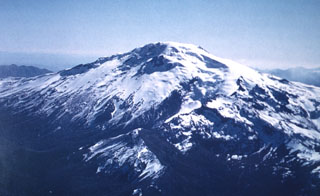Report on Callaqui (Chile) — December 1997
Bulletin of the Global Volcanism Network, vol. 22, no. 12 (December 1997)
Managing Editor: Richard Wunderman.
Callaqui (Chile) Stable during June-August 1997
Please cite this report as:
Global Volcanism Program, 1997. Report on Callaqui (Chile) (Wunderman, R., ed.). Bulletin of the Global Volcanism Network, 22:12. Smithsonian Institution. https://doi.org/10.5479/si.GVP.BGVN199712-357091
Callaqui
Chile
37.92°S, 71.45°W; summit elev. 3164 m
All times are local (unless otherwise noted)
A report received in early December noted stable activity during June through August 1997. The same report also described a new seismic system and some initial tremor and seismic data. The Department of Humanitarian Affairs of the United Nations sponsored a project that began in August 1997; this enabled scientists to study Callaqui under the auspices of the Observatorio Volcanológico de Los Andes del Sur (OVDAS) of SERNAGEOMIN and the Oficina Nacional de Emergencia del Ministerio del Interior.
The new seismic system includes a vertical-axis, 1-second-period geophone, a digitizer, and a computer. Upon collection, signals are telemetered and processesed by OVDAS in Temuco.
During August-October the tremor had characteristic frequency ranges from 0.9-1.6 Hz. For August-October the number of daily earthquakes averaged 0.96, 0.26, and 0.53 events/day. Seismic-amplitude averages (RSAM values) during the 3 months remained stable at 2.5.
Geological Summary. The late-Pleistocene to Holocene Callaqui stratovolcano has a profile of an overturned canoe, due to its construction along an 11-km-long, SW-NE fissure above a 1.2-0.3 million year old Pleistocene edifice. The ice-capped, basaltic andesite volcano contains well-preserved cones and lava flows, which have traveled up to 14 km. Small craters 100-500 m in diameter are primarily found along a fissure extending down the SW flank. Intense solfataric activity occurs at the southern portion of the summit; in 1966 and 1978, red glow was observed in fumarolic areas (Moreno 1985, pers. comm.). Periods of intense fumarolic activity have dominated; few historical eruptions are known. An explosive eruption was reported in 1751, there were uncertain accounts of eruptions in 1864 and 1937, and a small phreatic ash emission was noted in 1980.
Information Contacts: Gustavo Fuentealba C., Paola Peña S., and Klaus Bataille, Observatorio Volcanológico de Los Andes del Sur (OVDAS), Manantial 1710-Carmino del Alba, Temuco, Chile.

